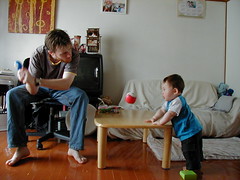Team Y,
On the whole I thought you lesson was well organized and very imaginative. I thought that you did a very good job with making the content of the textbook interesting! That is no easy task! I congratulate you for a good lesson and you all should be satisfied with their effort.
This lesson was very challenging to teach because the content was difficult for Naim (He told me to call him Naim and he does not need the "san".) He seemed to have trouble with the activity that you planned. The activity you planned was very good and interesting. The reason that Naim struggled was not the activity itself.
I think that Naim became a little confused when you introduced the material. First, when you started your skit, you did not tell Naim to page 22. I think it would have helped him to see the text. Next, I think you should have gone over the meaning of the sentences and explained the grammar a little bit. As I will explain below, Naim did not understand that "is" is a verb. Lastly, when introducing the New Words to Naim, you asked him "What does this mean?" This is fine, but you also could have written the sentence on the board and clearly told him that "What does this mean?" = "dou iiu imi desuka?"
I think it was also necessary to review the grammar. Today, I met with Naim and we went over the content of the textbook. I realized that he did not understand the verb "to be", so we studied that together for a while. His native language has the same structure as Japanese (ex. "Kochira ha Naim desu"), so the structure of English is quite confusing to him. I also have a feeling that his language does not conjugate verbs like English does and that his language does not have singular and plural like English thus. So it is necessary to focus his attention on gramatical forms.
Today, to explain the be verb, I showed him a lot of examples.
1) I'm Naim.
watashi ha Naim desu.
2) You are Yukari.
Anata ha Yukari desu.
3) This is Naim.
Kochira ha Naim desu.
4) That is Iwate University.
Sore ha Iwate daigaku desu.
I asked home to tell me the first sentence in Japanese. I explained to him than I'm is not watashi ha but is "watashi ha ~ desu".
We then translated each word to Japanese "I am Naim" "Watashi ha desu Naim".
He understood that the structure of English was different. I then asked him to guess the meanings of sentences 2, 3, + 4. He was confused about the meaning of "is" and "are". I told him they mean "desu". I also told him "shugo ni yotte doushi no katachi ga kawarimasu" but he did not understand me. The reason he did not understand was either my terrible Japanese or that maybe he is not familiar with Japanese grammatical terms. I think both can probably explain the reason he did not understand. He also did not understand the term "Ms." nor the difference between "Mr." "Ms." and "Mrs." He was quite surprised to learn the difference.
I think that in our next lesson with Naim san we should introduce the material much more SLOWLY and when teaching him new grammar compare it to the previous grammar (For example, comparing I'm, She is, This is, and you are.)
Anyway, again Team Y, you did a good job and I hope that you learned something about teaching from your lesson!
Thanks for your effort!





